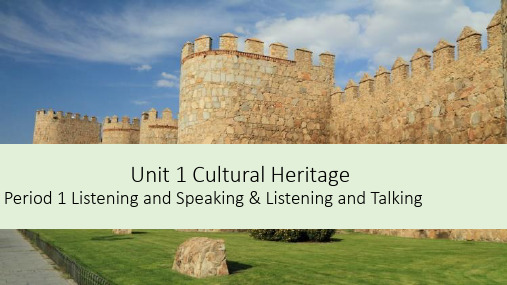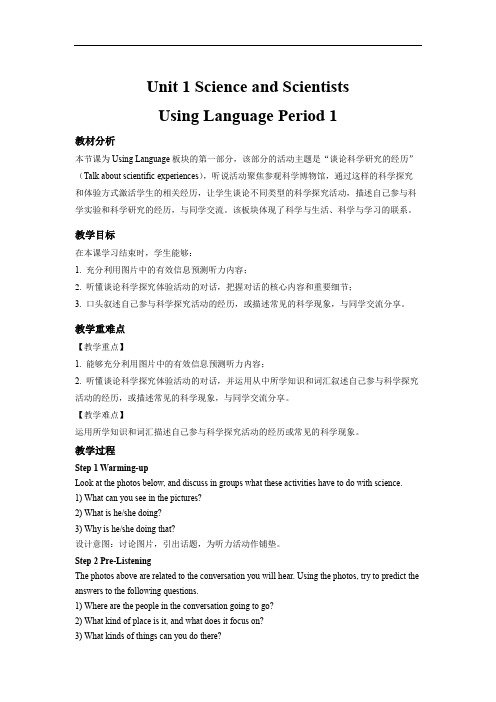高中英语人教版必修二unit1说课教案
- 格式:docx
- 大小:318.12 KB
- 文档页数:4


Book 2 Unit 1 第一课时学案I. 单词:1.cultural ________________2. design _______________3. relic ________________4. dynasty _______________5. survive ______________6. valuable _______________7. rare _________________ 8. fancy _________________9. style _______________ 10. troop ________________11. 接待,招待会_______________ 12. 装饰,装修________________13.选择,挑选_______________ 14. 移动,挪开15. 使吃惊,惊讶16.怀疑,疑惑II.短语:1. 寻找2. 属于3. 少于4. 作为回报,报答5. serve as __________________6. be at war ________________7. 充当__________________ 8. 值得做__________________III. 课文复习In search of the Amber Room他不可能想到他送给俄罗斯人民的厚礼会有这样一段令人惊讶的历史。
琥珀屋的设计采用了当时流行的别致的建筑式样,它是为一座宫殿设计的。
这间琥珀屋长约四米,被用作接待重要来宾的小型会客室。
1770年,这间琥珀屋按照叶卡捷琳娜的要求完成了。
有一段时间,两个国家进行交战,毫无疑问琥珀屋不见了。
从那以后,琥珀屋的去处便成了一个谜。
_______________________________________________________________________________ _______________________________________________________________________________ _______________________________________________________________________________ _______________________________________________________________________________ _______________________________________________________________________________ _______________________________________________________________________________ _______________________________________________________________________________ _______________________________________________________________________________Book 2 Unit 1Frederick William I , the King of Prussia, could never _1_ that his greatest gift _2_ the Russian people would have such an amazing history. This gift was the Amber Room, _3_ was given this name because several tons of amber was used to _4_ it. It was also decorated with gold and jewels. The design of the room was in the fancy style_5_ in those days, which _6_ the country’s best artists about ten years to make.Frederic William I, to whom the amber room 7_, decided not to keep it and gave it to Peter the Great. _8_ , the Czar sent him a troop of his best soldiers. The room _9_ a small reception hall for important visitors.Later, Catherine II had the Amber Room _10_ to a palace outside St Petersburg where she spent her summers. She told her artists to add more _11_ to it. In 1770 the room was completed _12_ she wanted. Almost six hundred candles _13_ the room, and its mirrors and pictures shone like gold. Although _14_ to be one of the wonders of the world, it is now _15_ . When Russia and Germany were _16_, some Nazis secretly stole the room it self. After that , _17_ happened to Amber Room remains a mystery. Recently, _18_ studying old photos of the former Amber Room, the Russians and Germans _19 a new Amber Room at the summer palace It was ready when they _20_ the 300th birthday of their city.1. A. imagine B. imagined C. have imagined D. had imagined2. A. for B. to C. from D. of3. A. which B. that C. where D. the one4. A. making B. made C. make D. in making5. A. popular B. welcome C. like D. as6. A. spent B. spending C. took D. taking7. A. built B. was built C. belonged D. was belonged8. A. In return B. In turn C. In appreciate D. In gratitude9. A. served B. serving C. was served as D. served as10. A. moved B. moving C. to move D. move11. A. details B. detail C. decoration D. pictures12. A. like B. at the will C. in the way D. by the way13. A. lit B. burnt C. filled D. decorated14. A. considering B. considered C. was considered D. seem15. A. missed B. broken C. missing D. burnt16. A. in war B. in the war C. at a war D. at war17. A. Something B. Which C. What D. That18. A. By B. while C. In D. At19. A. made B. were making C. have made D. have been made20. A. congratulated B. celebrated C. had D. heldBook 2 Unit 1 课文填空:Frederick William I, the king of Prussia, _______________________ that his greatest gift to the Russian people would have such an _________history. This gift was the Amber Room, ________was given this name because several tons of amber were used to make it. The design of the room was in the ________ style. It was also a treasure decorated with gold and jewels, which___________ the country’s best artists about ten years to make.In fact, the room was not made to be a gift. It was _______________ the palace of Frederick. However the next king of Prussia, ____________ the amber room belonged, decided not to keep it . And in 1716 he gave it to Peter the Great. ___________, the Czar sent him a troop of his best soldiers.Later, Catherine II ________the Amber room __________to a palace outside where she spent her summers. In September 1941, the Nazi army was near St Petersburg. This was a time __________ the two countries were at war. However, some of the Nazis secretly got to the summer palace and_________ the room. ____________________ that the boxes were then put on a train for German. After that, what happened to the Amber Room __________mystery.Recently, the Russians and Germans have built a new Amber Room at the summer palace. Since we _________highly of the Amber Room, do you think it is __________ rebuilding ?III. 句子:1. 他非常幸运从日本地震中活下来。



Unit 1 Science and ScientistsUsing Language Period 1教材分析本节课为Using Language板块的第一部分,该部分的活动主题是“谈论科学研究的经历”(Talk about scientific experiences),听说活动聚焦参观科学博物馆,通过这样的科学探究和体验方式激活学生的相关经历,让学生谈论不同类型的科学探究活动,描述自己参与科学实验和科学研究的经历,与同学交流。
该板块体现了科学与生活、科学与学习的联系。
教学目标在本课学习结束时,学生能够:1. 充分利用图片中的有效信息预测听力内容;2. 听懂谈论科学探究体验活动的对话,把握对话的核心内容和重要细节;3. 口头叙述自己参与科学探究活动的经历,或描述常见的科学现象,与同学交流分享。
教学重难点【教学重点】1. 能够充分利用图片中的有效信息预测听力内容;2. 听懂谈论科学探究体验活动的对话,并运用从中所学知识和词汇叙述自己参与科学探究活动的经历,或描述常见的科学现象,与同学交流分享。
【教学难点】运用所学知识和词汇描述自己参与科学探究活动的经历或常见的科学现象。
教学过程Step 1 Warming-upLook at the photos below, and discuss in groups what these activities have to do with science.1) What can you see in the pictures?2) What is he/she doing?3) Why is he/she doing that?设计意图:讨论图片,引出话题,为听力活动作铺垫。
Step 2 Pre-ListeningThe photos above are related to the conversation you will hear. Using the photos, try to predict the answers to the following questions.1) Where are the people in the conversation going to go?2) What kind of place is it, and what does it focus on?3) What kinds of things can you do there?设计意图:通过图片中的有效信息预测听力内容。

Unit 1, Module 2Welcome to the unitAims:Ⅰ. Learn about different mysteries .Ⅱ. Discuss about the unexplained things.Ⅲ. Learn some new phrases.PreparingⅠ. Words and phrases: advanced science and technologyrun intofor what reasona sunken shipCan’t tell?Find other words and expressions you don’t understand on p.1.Learning:Ⅰ. Lead-in:What do you think is the most mysterious things to you? Why?Ⅱ. Welcome to the unit:Picture 1What is the white thing?Why do you think so ?What does “Can’t tell〞mean?Picture 2What’s the animal?Where do you think you can find it ?What does “run into〞mean?Picture 3Is it a swam ? Why?Have you ever heard of Loch Ness Monster?Do you think it is true ?Picture 4What are the buildings ?Why were they built ?Picture 5What is the name of these stones ?Who built it?Why was it built?Ⅲ. Discussion:1.Do you believe in unexplained things such as UFOs,Yetis and monsters? Why or why not? 2.What other unexplained things do you know about?3.If you saw a UFO or a monster some day, what would you do?Ⅳ. Language points:1.tell:a.distinguish, know aboutCan you tell Tom from his brother?b.make outMary can tell the clock.2. run intoa.meet unexpectedlyI ran into an old friend in a pub last night.b. collide withThe bus got out of control and ran into a wall.Ⅴ. Homework:1.Learn the new phrases by heart.2.Collect more mysteries.3.Exercises.Exercises:Ⅰ.Workbook: p.91 Part BⅡ. Translate the following sentences into English:1.我不知道出于什么原因他没来参加我们的聚会。
英语必修⼆unit1教案英语必修⼆unit1教案【篇⼀:⾼⼀英语必修2 unit1教案】⽜津⾼中英语模块⼆(第⼀讲)主讲教师:邵磊主审:孙德霖【教学内容与教学要求】⼀、教学内容:⽜津⾼中英语模块⼆unit 1(上)⼆、教学要求:1.学会谈论有关宇宙空间的简单话题。2.学习阅读英语新闻综述。3.理解现在完成时和现在完成进⾏时的意义和⽤法。【知识重点与学习难点】⼀、重要单词:tale, unexplained, .alien, mystery, technology, monster, sunken(adj) stonehenge, pyramid, disappearance, multi-coloured,nightmare, detective, format, detail, paragraph, yeti, puzzle(nv), sighting, witness, creature, research, frighten, case, murder,convincing, evidence, typical, outer, progress, treasure, lately, website, wild, similar, hairy, strength, footprint, existe
nce, inch, exploration, orbit, launch, artificial, astronaut, oxygen.⼆、重点词组:run into碰到, believe in相信(信仰、理论、说法等), step up加紧, go missing失踪, show great interest in对….表现出极⼤的兴趣, due to因为, show up露⾯, according to根据, pull back拉开, do research on在….⽅⾯进⾏研究, rule out排除, look into调查, make up编造, take charge of负责, make a speech作报告, so
1 Book 2 Unit 1: Cultural Relics Period Three: Grammar (Page 4)
科目:英语 姓名:
课题 Subject Grammar point: the Restrictive and Non—Restrictive Attributive Clause
课时 Period The Third Period
课型 Lesson Type
New Lesson
教学目标 Teaching Aims 1. 知识与技能目标 1) Get students to obtain how to decide the relative of the Attributive Clause correctly. 2) Let students clearly know the differences between the Restrictive and Non-Restrictive Attributive Clause. 3) Make students understand the distinctions between the relative “as” and “which” in Non-Restrictive Attributive Clause. 2. 过程与方法目标 1) Develop students’ skill to analyze specific problems and enable them to learn how to adopt different strategies to solve different problems efficiently. 2) Have students learn to apply the grammar into their writing, reading and speaking. 教学重点 Key Points Learn how to tell the differences between the Restrictive and Non-Restrictive
Attributive Clause 教学难点 Difficult Points
1. Learn the differences between the Restrictive and Non-Restrictive Attributive Clause. 2. Learn how to apply the knowledge of the Restrictive and Non-Restrictive Attributive Clause. 教学方法 Teaching Approaches
1. Questioning 2. Explaining 3. Collaborating 教学辅助 Teaching Aids PPT;Blackboard;Test Paper;
教学过程 Teaching Procedures Step1: Leading-in(导入——了解重点) 1) Give the students a group of sentences. (This is the scientist. His achievements are well known.) 2) Lead the students to find out the relation between the two sentences. 3) Let the students try to combine the two sentences into one with the knowledge 2
they’ve learnt in Book 1. (This is the scientist whose achievements are well known.) 4) Ask the students what grammar they’ve used when they combined the two sentences. (the Attributive Clause) 5) Introduce the language point of Unit One (the the Restrictive and Non-Restrictive Attributive Clause). Step2:Review(知识回顾——温故知新) 1) Let students do some exercises and ask them to think over the following questions. a) What is the Attributive Clause? b) How to decide which relative we should use correctly? What are the relatives of the Attributive Clause? Exercise: 1) The man came here just now is my father. 2) Is this the man you just talked to? 3) This is the shop sells medicine. 4) The film we saw yesterday is interesting. 5) This is the boy mother is a doctor. 6) It was a meeting importance I did not realize at that time. 7) I still remember the day I first came here. 8) This is the house I lived last year. 9) I don’t know the reason he was late.
Step2: Fast reading(快速阅读——主动探究) 1) Read the passage quickly and underline all the sentences with attributive clauses. a) This gift was the Amber Room, which was given this name because almost seven thousand tons of amber were used to make it. b) The amber which was selected had a beautiful yellow-brown like honey. c) It was also a treasure decorated with gold and jewels, which took the country’s best artists about ten years to make. d) However, the next King of Prussia, Frederick William 1, to whom the amber room belonged, decided not to keep it. e) Later, CatherineⅡ had the Amber Room moved to the palace outside St Petersburg where she spent her summers. f) In 1770, the room was completed the way she wanted it. g) This was a time when the two countries were at war. h) There is no doubt that the boxes were then put on a train for Konigsberg, which was at that time a German city on the Baltic Sea. 2) Look at Sentence (a); (c); (h) carefully. Get students to tell the differences from the others. There is a comma before the relative pronoun “which” in Sentence (a); (c); (h). 3
Step 3:Comparative Analysis(对比分析——实际感知) 1) Give students two group of pictures and ask them to describe them with the Restrictive and Non-Restrictive Attributive Clause. Compare and analyze the differences between the two pictures in each group. Make students perceive the usage of the two kinds of Attributive Clauses. Group1:
I like the girl who wears a red coat. I like the girl, who is walking a dog. Group 2:
The man has a son who is a painter. The man has a son, who is a painter. 2) List a table to summarize the differences between the Restrictive and Non-Restrictive Attributive Clause in a detail. Make students obtain the important point more clearly.